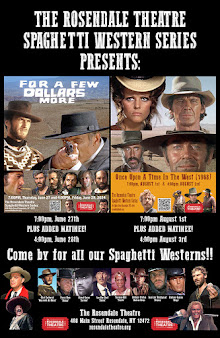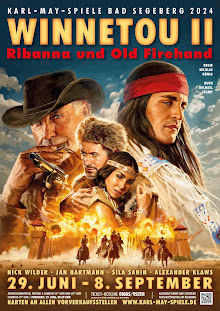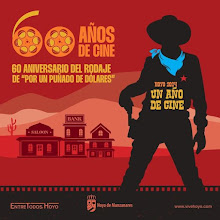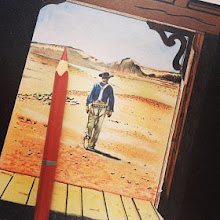El Debate
By César Wonenburger
May 16, 2023
[Sergio Leone and Ennio Morricone, in an interview on
Italian television in the 60s]
A new documentary recovers the figure of the director who
for Spielberg made films "like nobody else", together with the
influence of the composer without whose music would not be understood For a
Fistful of Dollars or Once Upon a Time in America.
When Clint Eastwood agreed to dedicate the vacation left
by his job on television in his country to shoot, between Rome and Almeria,
Death had a price, second installment of the so-called Dollar Trilogy, in
exchange for fifty thousand dollars, only had one request. He wanted his
laconic character, with those dry and ironic drops of humor, a kind of James
Bond of the Far West, to give up tobacco. But Sergio Leone, the director who
had first recruited him for his previous film, For a Fistful of Dollars, while
the actor was just an unknown who made a living working on a modest series, was
adamant. That cylinder of nicotine eternally perched between his lips had come
to acquire a prominence of its own, essential. So he stayed. For something in
Italy, Eastwood, one of the most popular personalities among the clients of the
glamorous terraces of the Via Veneto of the 60s, was known as "Il
Cigarrillo".

[Clint Eastwood with his famous cigarillo between his
lips in the movie ‘For a Fistful of Dollars’]
Leone always had very clear ideas, despite his nervous
tics typical of the insecurities of genius. He knew perfectly well that in Art
commitments, however small, often lead to enormous disappointments. After
having reached maximum glory with his personal and risky turn of the screw to
the western, allowing himself to reject juicy commissions such as The Godfather
in the meantime, it took him almost three decades to set up his definitive
work, Once upon a time in America. And once he finally managed to capture it
true to his vision, shooting almost for twelve intense months of repeated shots
until exhaustion to fix his daydreams as the imagination, and the experience of
a lifetime, had dictated it, the bosses of the Hollywood studio decided to
massacre it to make it “more accessible”.
They cut his assembly in more than an hour until it was
unrecognizable to him, who never wanted to get personally involved with that
pickle. He never recovered from the blow. He would not shoot again, not even
that Leningrad for which Gorbachev had promised to give him all the troops of
the Soviet army, including tanks, and whose opening scene began with
Shostakovich’s hands on the keyboard of a piano composing the symphony that
would serve as the soundtrack of hope against the Nazi siege of the city. In
one of the most epic and bloody episodes of World War II. Leone would live even
a little longer, he said goodbye in 1989, but who knows if that upset
precipitated his early end with 60 years.
Leone, true to his principles
His widow later confessed sometime later that the
producers had never been too conducive to them. Loyal to his principles, that
Neapolitan Grimaldi – famous surname of a lineage of pirates who settled among
the rocks of Monaco, until today – had tried to fleece him several times on the
occasion of the filming of his "spaghetti-westerns". Be that as it
may, Leone achieved his purpose, the one that gives meaning and fullness to a
life: against all odds he succeeded in making several of his childhood dreams
come true, prolonging those of his father, Vincenzo, an actor and director
retired before his time.
He conceived a handful of films like those that had fed
his main happy hours in those years spent in Roman Trastevere, but enriched
with his personal touch, fruit of that style that began to be forged through
the viewing of the great titles of Walsh, Hawks or Ford, to which surely we
should add a very solid knowledge of the expressive ways of silent cinema. of
masters such as Griffith or Murnau, and even of his own father, who signed his
contributions as Roberto Roberti.
The cinema is a choral, collective endeavor, but in the
end the one who signs is god, as the figure of the director is known in the
shootings. Some of the collaborators who worked with him, especially a couple
of screenwriters, were never very happy with the fact that the glory fell
almost entirely on his oronda figure, attributing a kind of narcissism and
egomania consubstantial to every creator, however minor he may be, much more
when it comes to someone who has managed to taste the honeys of that
multitudinous success, with clear influence on the current account, which in
the case of Leone was also reflected in several succulent episodes.
[The film 'Once Upon a Time in America', by Sergio Leone]
Like the time in which in a Florentine cinema they had to
warn the police because a large group of exalted spectators tried to enter the
room, already occupied to the very brim, because they refused to stop attending
one of their best known films, in which both doubting and melancholy heroes and
unscrupulous ruffians exhibited a mutant morality that brought them closer to
their audience in a way rarely shown.
The modernity of the director born in 1929, so
suggestive, consisted in not establishing simple distinctions between the just
and sinners: both could constitute the reverse of the same worn coin according
to the circumstances. As in life itself, in that dusty and sweaty universe of
urgent passions gray predominated. But served not with the crudeness of a
neorealism that aspired to capture and serve a crude picture of existence
without attachments, with the right means. The sense of spectacle was
non-negotiable, the basis of its communion with the public for a filmmaker
raised in the Eternal City, where in each new walk the greatest pleasures
destined to one of the essential senses for artistic delight, sight, are
offered without reservation.
The arrival of Morricone
Hegel restricted the sensibility of art to "the
theoretical senses", sight, of course, but also hearing. Both would shake
hands in an almost unexpected way when Leone began working with one of his
former classmates, who had lost track, the composer Ennio Morricone.
"Leone had the eyes and Morricone the sound," summarizes Steven Spielberg
in the documentary Sergio Leone: the Italian who invented America, presented
last summer at the Venice Film Festival and incorporated into the SkyShowtime
platform offer these days. The most outstanding pupil of the Italian director,
Quentin Tarantino, insists on the same idea: "Morricone is the co-author
of Leone's films, to the point that you cannot imagine them without his
soundtrack."
In this joint work both restored to the cinema values
that were believed to have already been overcome through a literary conception
that held it tightly to the novel, such as in most current series. As in those
films of the silent era to which his father had contributed so much, from
Italy, the author of The Good, the Bad and the Ugly restored to the pure image,
in absolute connivance with the sound (Morricone, connoisseur of musique
concrète, former student of Cage, gave it an essential value), a mode of
expression clearly superior to the mere illustration of a text. Beyond serving
as a complement that elevates emotion, the music of his films informs,
dialogues, suggests and discovers.
[Poster of the documentary 'Sergio Leone: the Italian who
invented America', by Steven Spielberg]
The conception of work that Morricone had begun to
develop in other film works, but also in the skillful transformation of the
popular music of his time, arranging melodies sweetened with subtle dressings
of ironic distancing directly related to the resources proposed by the musical
avant-garde, acquired its full meaning in the collaborations he developed
together with Leone. That surprising onomatopoeic parade, the bold mixture, not
without wisdom, of the howl of a coyote with the ringing of a bell, a guitar
riff and the impossible vocalizations of a soprano, the penetrating sound of
the harmonica or a whistle to the fullness of a symphonic ensemble at the
service of a melodic discovery constituted no longer a simple accompaniment, A
filler with which to put the emphasis on this or that emotion.
All this fascinating hybrid and synthetic fabric managed
to overlap in the development of the story and the characters, sometimes
promoting unexpected meanings, associations, nuances. As in Wagner's operas,
beneath the mask, music could serve to reveal the real thought, the hidden
intentions of the protagonist or any of the secondary, beyond the surface of
the actions. In this way, what Morricone himself defined as "the abstract
interpretation of words", their opaque meaning, was verified.
Such was the importance that Sergio Leone attached to the
work of his old friend that in his last collaborations he established a method
that Herbert von Karajan would adapt, in some way, for several of his operatic
productions in Salzburg. Karajan first recorded the music with the same
performers who months later would bring it to the stage. In this way, at the
time of rehearsals, the sound previously recorded with their own vocal cords
was heard through speakers, allowing the artists to concentrate during that
moment only on the acting movements, at least until the last tests.
For the filming of that immense ode to the Seventh Art
that is Until its time came, Leone led the composer to previously record the
entire soundtrack, so that it was always heard on the set, during each scene.
Beyond Karajan's perfectionism, which also sought the greatest concentration of
efforts, Leone intended to convey to his interpreters the overall dramatic
sense of his intentions, to capture the full atmosphere, something that for him
was only possible if they managed to impregnate themselves with the music. A
unique method that gave Morricone's work its absolute letter of nature.
['Once Upon a Time in the West', by Sergio Leone]
That co-authorship claimed by Tarantino was undeniable
despite the modesty of the musician, who did not consider himself at the height
of a screenwriter, at best, a privileged interpreter of the author's true
intentions, of the psychology of the characters. The now deceased composer told
a wonderful anecdote, revealing his discreet personality, of Until his time
came. During filming, Leone decided to dispense with the music that the
composer had created, and recorded, for the opening scene, one of the most
iconic in the history of cinema. Far from being enraged, Morricone agreed with
him without reservation. Those characteristic sounds, such as the noise of the
mill, constituted in their eloquent nakedness the best possible symphony to
communicate the anguish of waiting, "an unparalleled music"
Leone and Morricone stayed together until the end,
rendering a last joint service to the cinema in that Once Upon a Time America
that, according to Robert De Niro, the director almost refused to conclude as
if he wanted to stay to live eternally hung in the evocation of some of the
memories of his childhood, the time of innocence and discovery, in that
first-time kiss that actress Jennifer Connelly, a debutante of just 11 years,
had to play in one of her most captivating scenes. La Connelly, who would have
loved to be able to treat him as an adult, has never forgotten the experience
or the affection with which the director knew how to wrap her in such a
delicate moment for her. He still gets excited to evoke it.
According to Spielberg, this testamentary work,
crepuscular like the Velazquez tones of the sunsets of those westerns that he
wanted to evoke from the distance of his European tradition, impregnating them
with thin layers of humor that would file their roughest and most complex
contours, but always faithful to a way of fabular that privileges above all the
dazzle, The astonishment that fights boredom, is "his best conceived
film". A statement that acquires greater emphaticness, meaning and
thickness because for the author of Jaws "nobody made films like him,
before or after. He found a way to tell stories that no one even came close
to."
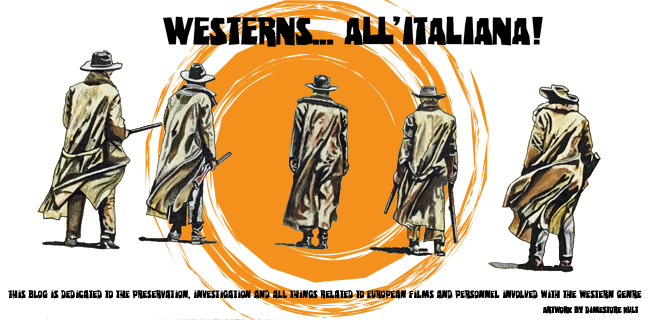
.jpg)












.jpg)





















